Last Updated on May 3, 2022
When you were learning to drive, your parent or driving instructor probably told you to only use one foot between the brake and gas pedals.
Back then, chances are good that most vehicles you saw came with a three-pedal manual transmission (which is why it was known as a “standard transmission” back in the day). When driving a stick shift, using both feet was necessary.
But does the rule of using only one foot between the gas and brake pedals still apply now that the vast majority of our vehicles have automatic transmissions?
Related: Riding the Clutch Pedal? (Why You Should Stop)
The Case For Two Feet
#1 – Reaction Time

If I hold one foot over the brake while I’m driving, I can instantly depress the brake pedal in case of a sudden obstruction ahead.
This reduces the amount of time it takes between when I see a hazard and when I am able to slow the car, thus reducing my braking distance.
#2 – Accidentally Hitting the Gas

Additionally, I no longer have to worry about hitting the gas instead of the brake by mistake. My legs are naturally aligned with the pedals so there is little risk of my braking foot accidentally hitting the gas pedal; my right foot is now in the way.
If you follow the news, you’ve likely seen stories about vehicles that end up crashing through the front windows of convenience stores, restaurants, or other storefronts.
According to a study by Media Advisory, in 34% of these cases, it is due to pedal error where the driver (usually elderly) intends to step on the brake pedal but instead steps on the accelerator or their foot slips from the edge of the brake pedal onto the gas pedal.
Because the first thing the car will hit is either the wheel stop or curb, that sudden jolt will cause the driver’s foot to then be pushed harder into the gas pedal. While no data is provided, it’s more likely the majority of these drivers are one-footed drivers who simply had a moment of confusion and pressed the wrong pedal.
#3 – Keeping the Turbo Spooled
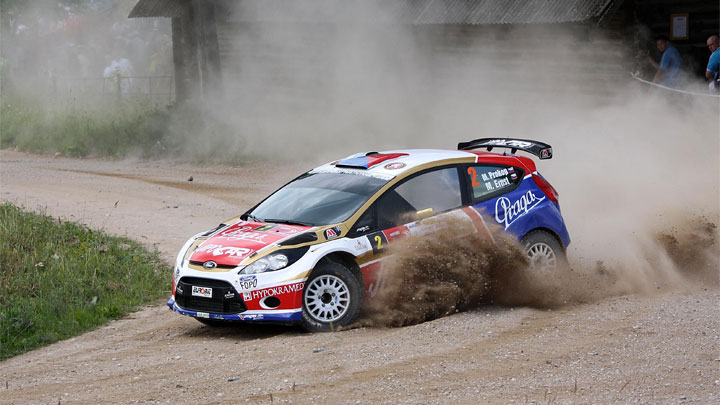
Fun fact: Racers who drive older rally cars use left foot braking to keep the turbocharger spooled while they are braking for a corner.
In theory, drivers of some turbocharged vehicles on race tracks could enter and exit corners at faster speeds by using some throttle while braking. Using both pedals at the same time actually them to do some of the steering with their feet.
But for practical purposes, this would have almost no benefit to normal drivers on today’s roads and as you’ll see below, pressing both the brake and gas pedal at the same time can have some unintended consequences.
Driving with both feet seems to make sense, doesn’t it? If I have two feet and two pedals, there is a 1:1 relationship between them. While this seems great on paper, it doesn’t quite pan out in practice.
Is Driving With Both Feet Illegal?
Similar to driving barefoot, it’s not illegal, but it is still ill-advised.
When it comes to driving, everybody has their preferred way of getting around in the safest, most efficient way possible. If you are dead set on using both feet to drive your car, there is little I can say to dissuade you… but I will give it my best shot anyway.
The Case for One Foot
#1 – The Dead Pedal
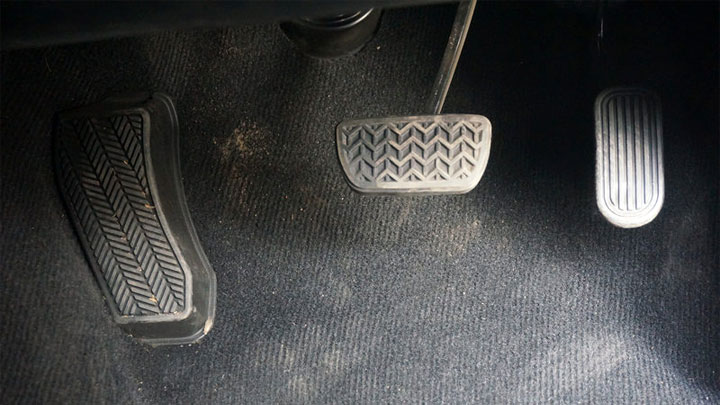
When I went through driver’s education, my instructor taught me to keep my left foot on the dead pedal. For those who don’t know, a dead pedal is a stationary pedal on the leftmost side of the floor. It’s not attached to any mechanical components; its sole purpose is to stabilize the driver.
I didn’t quite understand this until I started learning high performance driving.
Your legs contain some of the strongest muscles in your body and are designed from the ground up to support your weight. If I try to brake or corner hard without my left leg pushing firmly into the dead pedal, I will slide around in my seat.
Sliding around in your seat makes it more difficult to operate the controls smoothly. If you’re not driving smoothly, the likelihood that you will lose control of the vehicle increases.
Not planting your left foot on the dead pedal will eventually lead to driver fatigue since weaker muscles are then required to compensate for your legs to keep you from flying all over the inside of the car like a wacky waving inflatable arm flailing tube man.
If you brake with your left foot, your foot either has to travel farther from the dead pedal to the brake or hover over the brake pedal.
The former increases the time it takes to apply the brakes from the moment you spot a hazard and begin to react, since the dead pedal is farther from the brake than the brake is from the gas.
The latter increases fatigue, as your shin or hip flexor muscles would be partially contracted for extended periods of time.
#2 – Reduced Fuel Economy, Increased Brake Wear

If you get tired from hovering over the brake, you may end up resting your foot on the brake pedal. Doing so (even gently) would apply slight brake pressure, which would heat up the brakes, cause the pads to wear out faster, and possibly warp the brake rotors.
This will also reduce fuel economy and put more strain on the engine, as it has to work harder to overcome the drag from the brakes. This is known as riding the brake and you’ve probably noticed other drivers doing it where their brake lights are always on, even while accelerating.
If you’re always applying some pressure to your brake pedal, your wallet will start to notice.
Related: Does Using Cruise Control Save Fuel?
#3 – Sudden Unintended Deceleration

You may have heard of recalls on certain automobiles referring to “sudden unintended acceleration”.
This can happen for a variety of reasons: a floor mat got wedged under the gas pedal, the throttle position sensor failed (causing the car to think the driver was asking for 100% throttle), or there was a malfunction in the engine computer’s programming.
What happens on a modern car when you press the brake and accelerator at the same time? No, sadly your car does not take a screenshot.
To combat unintended acceleration, many manufacturers have added programming as a safety measure that causes the vehicle to come to a stop when the brake and accelerator are pressed at the same time. This ensures the driver is still able to stop even if the throttle is wide open when brakes are applied.
If you accidentally rest your foot on the brake while you’re giving the car gas, the vehicle could come to an abrupt stop and cause an accident.
The exact brake threshold required to trigger this function differs from vehicle to vehicle as it depends on the manufacturer’s programming, but it’s not something I would personally take a chance with.
Your owner’s manual may contain more specific information if this feature is present on your vehicle.
See Also: Semi-Automatic Transmissions (How They Work)
Conclusion
Though I’m not a professional driver, I’ve dedicated a lot of time and energy to improving my driving skills. Cars are a big part of my life, and I care a lot about educating others about safe driving practices.
Many of the techniques I’ve picked up are applicable in a wide array of situations, both on the track and the public road. While it may be possible to safely use two feet to drive an automatic, I don’t think the risks outweigh the rewards.
If you know a left foot braker and found this article helpful, please share it with them. Together we can make the road a safer place.

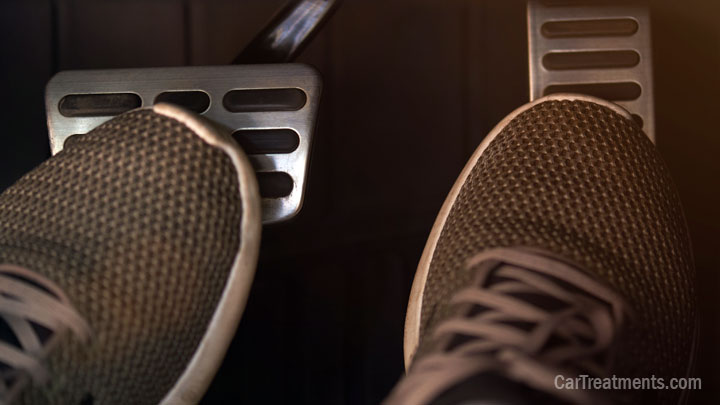

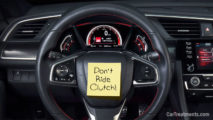
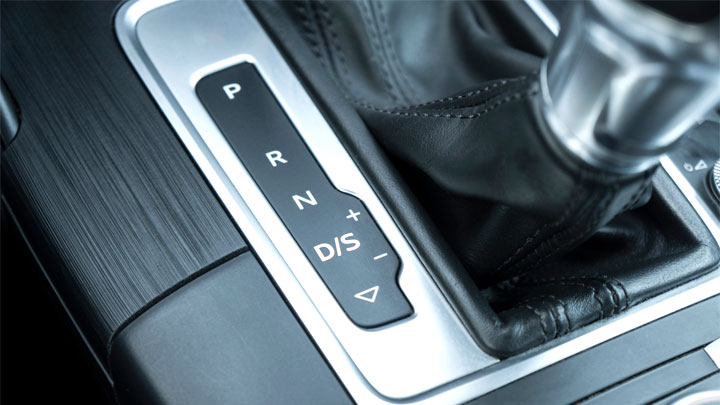
I AM a professional driver and I completely disagree with you on this. Two-feet driving is smoother, faster and safer. Resting your left foot on the brake pedal is the work of an idiot, not a two-foot driver.
I’ve been 2 foot driving about 56 years, and it’s been 50 years since my last highway accident. Over a million accident free miles.
I also circle track race, almost 30 years of that. I two foot it too. That’s with a straight stick. I one foot it until I get to the gear I’m racing in, then shift to two foot driving during the race,
Two foot driving has saved me from several wrecks on both the highway and the track, that faster reaction time made a difference, several times.
If you’re a clutz don’t try it.
I drive both automatics and straight stick on the highway, and straight stick only on the track. I have no trouble transitioning between the two, even though with the straight stick I’m two footing it in tight traffic.
At 72 I see no need to change, I still know my left foot from my right, and where they are. When I don’t, I’ll take myself off the road.
Anyone that is still driving an automatic with one foot is living in the dark ages. There is nothing safer and more natural than driving with two feet. It’s time to start teaching people how to drive smootly, safely and to be able to react quickly. The amount of time it takes to go from the gas to the brake is ample time to kill someone. People that claim that you may press on the gas when emergency braking is like saying you shouldn’t have both hands on the wheel because they may fight each other.
Completely disagree! Everyday I see multiple drivers riding their brakes on my way to work. When I used to work at a Dodge dealership we’d constantly get people complaining about the poor gas mileage they’re getting when they would come in for an oil change. Even before checking their brake pads, we knew they would probably be down to 2-3mm even though we changed them a year ago.
Sure some people can handle driving an automatic with 2 feet but in my experience, most can’t. When an emergency situation pops up, a 2 footed driver more often that not will push both feet to the floor. This alone should be reason for not teaching the 2 foot method to new drivers.
I love a good argument but I like to get argument to contain good information from whatever side is winning although my friend and sis that you put driving is the best how can you deny the facts that it’s harder on your car harder on your gas mileage and more risky in accident situation thank you for this information
If one of your cars has an automatic transmission and the other has a manual gearbox, braking with the left foot is more of a challenge. Here’s why. A good manual gearbox driver learns to use that left foot very effectively on the clutch pedal. And in a panic stop he will reflexively jam the clutch in with the left foot while hitting the brakes hard with the right foot. Works great with the manual gearbox.
But when you hop into the other car (the one with the automatic), panic stops go like this: You see the sudden danger; your right foot hits the brake; your left foot wants to jam in the clutch, but it hits the brake instead and extremely hard (no modulation whatsoever). ABS can be of benefit here, but even so the sudden unexpected hard braking can lead to loss of control of the car.
So my recommendation is this. If you only have cars with automatic transmissions, learn to brake with the left foot. If you hop from the auto-equipped car to the manual-equipped car quite regularly, then stay with braking using the right foot only.
Very well said. However, I stand by my original argument that all drivers (except in very specific professional instances) should brake using only their right foot, regardless of transmission type.
Proper driving technique has you resting your right heel on the floorboard, and pivoting your foot between the gas and brake as needed. With your heel resting on the floor, you have really great control over brake and throttle modulation and can pivot between them in an instant. In this position, you’re modulating the pedals using mainly your ankle, not your hip and thigh. This gives you greater control over the vehicle.
If you were to brake with your left foot, one of two things would need to happen:
1. You would have to move your left foot from the dead pedal, rest your left heel on the floor next to your right heel, and then you may apply the brake with proper modulation. This takes a fair amount of time, and you risk having your feet get in the way of each other since they are so close together.
2. You would have to constantly hover over the left brake pedal with your left foot. This leads to left leg fatigue and a decreased ability to modulate the brake pedal properly. In other words, the problem you outlined for manual transmission drivers would still apply to automatic drivers.
Qualifier, I am a race car driver, formerly held a professional license, and a daily driver left foot braker.
1.) Your comment about driver fatigue may apply over an hours time, but most trips are far less than an hour. Not to mention your left foot doesn’t hover the entire time (think stoplight), so that claim is thrown out the window.
2.) And the most important point is accident avoidance. The time it takes to apply pressure to the brake pedal is critical. Your claim that standard right foot braking allows you to transfer “in an instant” is categorically false when compared to the time to apply pressure to the pedal with the left foot.
If you wanted to make your case more scientific, you could do a sample set of drivers (half left foot, half right foot), have them drive at a particular speed, same car, then randomly provide a braking event representing an obstacle and see who stops faster. I’d just guess that reduced stopping distance by left foot brakers would change your mind.
You will probably not find a driver’s education course that advocates for left foot braking, though the practice is encouraged in some racing disciplines such as rally.
Since you are a race car driver, you probably know that racing and street driving are completely different applications. Proper technique in racing does not necessarily apply to the street, and vice versa. For instance, you would probably get rear ended eventually if you tried to threshold brake at every stoplight.
Anyone who drives a manual transmission (like me) is likely to get confused braking with the right foot while driving stick, then braking with the left foot while driving an automatic. Those of us who still drive manual transmissions should probably stick to braking with the right foot.
Hovering over the brake will lead to leg fatigue eventually. If you are not hovering over the brake with your left foot, your left foot would have to be resting on the floor. In other words, there would still be a delay from the time it takes to pick your left foot off the floor and apply the brakes.
For a fair scientific test, drivers would need to have both feet resting on the floor, not hovering over a pedal, since nobody drives that way for a long period of time. On the highway or freeway, most drivers set cruise control and rest both feet on the floor.
With that said, let’s call it a wash in terms of the time it would take to apply the brakes with either foot. Your reaction time, tire traction, and ABS are likely to be bigger factors in your stopping distance than which foot you’ve trained with in a panic braking scenario.
I’m pretty certain I can go from gas to brake with my right foot faster than any left foot braker.
“Anyone who drives a manual transmission (like me) is likely to get confused braking with the right foot while driving stick, then braking with the left foot while driving an automatic. ”
So only a few special people can play piano or guitar? It will become instinct after a few days practice.
I agreed with left braker for fast reaction when needed to stop the car and accelerate out of collision.
I have been driving with 2 feet for 41 yrs in busy Los Angeles roads and no ticket or accident.
Avoid accidentally step o nthe gas instead of brake as one foot drivers.
Congratulations on your accident free driving record.
No F1, Indy Car, Rally or Go Kart driver drives with 1 foot (BTW it’s impossible to drive with 1 foot in a Go Kart, the steering is between your legs).The Indy 500 is 3-5 hours long and they don’t have an issue. If you practice driving with 2 feet it will become second nature and more efficient. My father drove 2 footed, I drive 2 footed and my son drives 2 footed. It’s the best way by far.
I drive two-footed and don’t ride the brake. My left foot is cocked off my heel. I’ll concede one thing: long hours of that creates wear on the heel of dress shoes, especially with the delicate cloth of some women’s shoes. That’s why I don’t drive in them for any appreciable distance. You’ll see me switching shoes when I arrive. Other than that, I don’t see any disadvantages.
The passionate argument in the story about left leg fatigue doesn’t take into account that our left leg muscles are in use all the time (not sitting on the rest pedal) and in shape to do the job. I’ve never felt that fatigue, even after driving long days.
And about the argument that if you don’t keep the left foot on the rest pedal, you risk sliding around, I have to laugh. Who slides around in a bucket seat? I’ve driven a bench seat vehicle before and that argument definitely applies. I adjusted to it and drove one-footed so the other was on the rest pedal. The novelty of it kept me on my toes. Other than for unlikely emergencies, I won’t be driving pickups with bench seating.
I’ve driven with 2 feet my whole life and it is so ingrained and second nature that I cannot fathom some of these reasons you came up with. I have never accidentally hit the brake, nor do I rest my left foot on the brake pedal. Why would I?
Would a one foot driver accidentally hit the brake instead of the gas? Usually not! Even though it makes more sense for a 1 foot driver to have the mixup. I’ve been in plenty of accidents and I never hit both pedals at once. I hover my left foot most of the time, or set it down sometimes for long drives.
Alot of these risks you’re talking about seem ridiculous to me, in all honesty.
Sounds like two-footed driving is not an issue for you. That’s good. In your case, I would focus on what could be done to prevent getting into those accidents in the future.